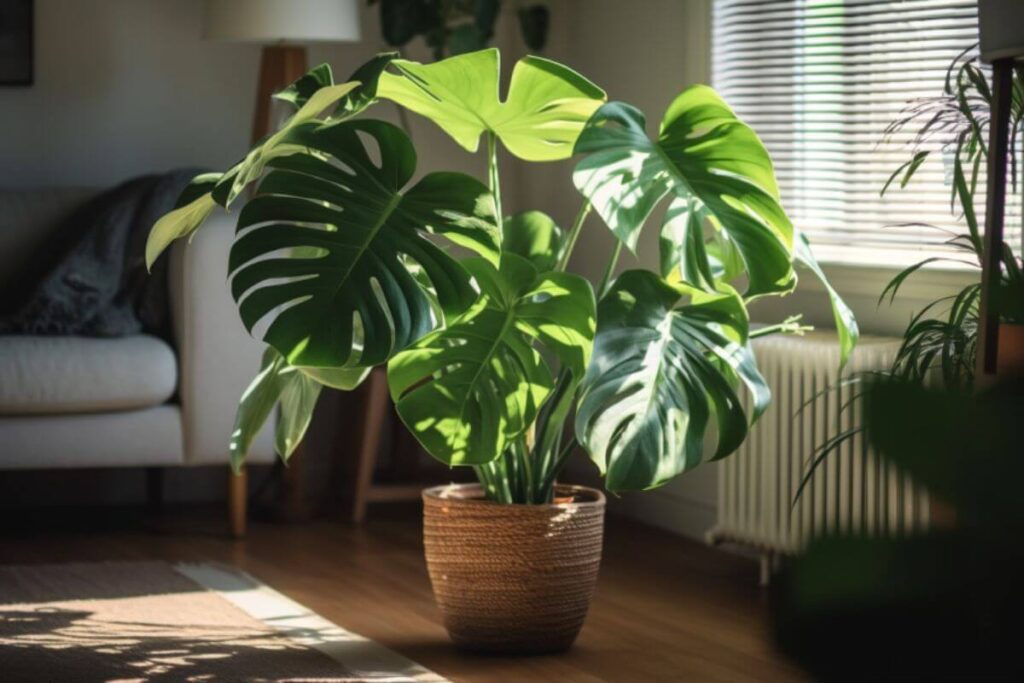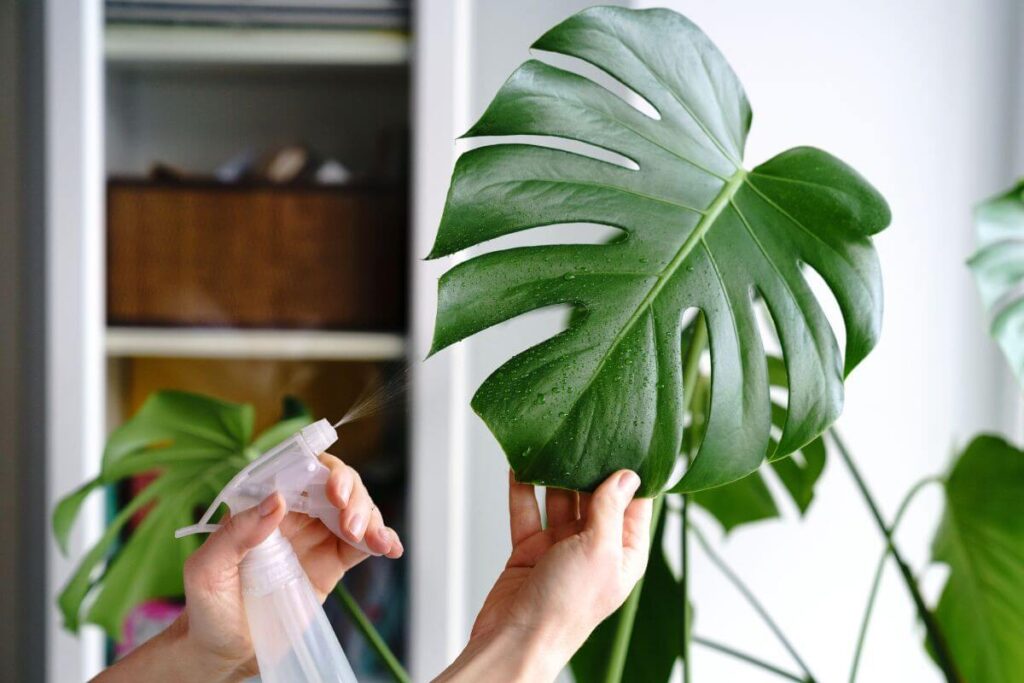So you’re loving your Monstera Deliciosa plant, taking great care of it, but you’re wondering: “When do Monstera leaves split?”
As a houseplant enthusiast, I understand the excitement of watching new leaves unfurl. Monstera leaves typically split when the plant reaches maturity, which can take several years.
However, I know you may not want to wait that long. That’s why I have a few tricks up my sleeve for you to encourage leave splitting in your Monstera.
In this blog post, we’ll explore the factors that influence Monstera leaf fenestration and discuss the best care practices to encourage healthy leaf development.
Whether you’re a new plant parent or a seasoned gardener, understanding the timing of Monstera leaf splitting can help you better care for this popular, stunningly beautiful houseplant.
Let’s go!
What is Monstera Deliciosa?
Monstera deliciosa, also known as the Swiss cheese plant, is a stunning and low-maintenance plant that has gained immense popularity among indoor plant enthusiasts.
Its unique foliage, characterized by large, glossy, heart-shaped leaves with natural leaf-holes, adds a touch of exotic flair to any living space.
Monstera is native to the tropical rainforests of southern Mexico and Central America. It belong to the Araceae family and is prized for its lush green foliage and adaptability to indoor environments.
What I love about Monstera is its staggeringly fast-paced growth under ideal conditions. Before you know it, your baby Monstera will be as tall as you and reach for the ceiling with its gorgeous leaves.
The natural leaf-holes, termed fenestrations, give the plant an exotic and whimsical look, adding a touch of intrigue to its visual appeal. And they make sure each plant is 100% unique, too.
If you’re new to growing houseplants and are looking for relatively easy plants to start with, Monstera is the perfect choice for you. It thrives in indirect light and can tolerate infrequent watering, making it an ideal choice for busy plant lovers or those new to indoor gardening.
Just make sure you can offer your Monstera plenty of space: this plant can grow to be quite large, often reaching up to 3 feet in length, making it a striking addition to any room.
Overall, Monstera deliciosa combines visual allure with ease of care, making it a beloved choice for plant enthusiasts seeking both aesthetics and convenience in their indoor greenery.
What Does “Splitting” Mean for Monstera Leaves?
When we talk about Monstera leaves splitting, we are referring to the formation of the iconic slits and holes that are characteristic of these tropical beauties. It’s a fascinating process that adds to the unique allure of the Monstera plant.
The splitting of Monstera leaves is a natural occurrence as the plant matures. As the leaf grows, it develops new fenestrations, which are the splits and holes that give Monstera leaves their distinctive appearance.
This process is a sign of a healthy and happy Monstera plant, and it contributes to the plant’s ability to adapt and thrive in its environment.

Why Do Monstera Leaves Have Holes?
When a Monstera plant is young, its leaves are whole and unblemished, lacking the characteristic splits and fenestrations. That’s how the smaller plants at nurseries look: the leaves are whole and you won’t see much fenestration there yet.
But as the plant matures, the new leaves will develop slits and holes. Hence, an aging Monstera won’t develop holes on older leaves. Once a new leaf develops, you’ll instantly see how it’s going to look.
So why do Monstera leaves developer holes in the first place?
Developing holes and slits on the leaves is the plant’s way of maximizing its exposure to sunlight and minimizing wind resistance.
The gaps in the leaves allow light to filter through, reaching lower parts of the plant, while also reducing the force of the wind on the foliage.
Thus, the split leaves allow the plant to thrive in its natural habitat. In the wild, Monstera plants grow as epiphytes, clinging onto trees for support. By developing fenestrations, the leaves can survive heavy rainfall by allowing water to pass through, reducing the risk of damage or rot.
Aside from their functional benefits, the holes in Monstera leaves contribute to their aesthetic appeal. The striking patterns formed by the perforations add an artistic touch to these tropical plants, making them a popular choice for interior decor. It’s as if nature itself has carved out intricate designs, turning each leaf into a work of art.
But when will your Monstera leaves split exactly? Let’s have a look…
When Will Monstera Leaves Split?
I remember being so thrilled when I noticed the first split leaf on my first Monstera plant. It felt like a personal victory that I had cared for this stunning plant so well that it rewarded me with a new, unique leaf.
If you’re eagerly waiting for your Monstera to start showing off its iconic splits, let’s delve into the timeline of when you can expect those beautiful fenestrations to appear.
Initial Monstera Growth Stage
During the initial stage of growth, Monstera plants start with solid, unbroken leaves. This is a crucial stage as the plant establishes its root system and develops its foundation for future growth.
At this point, the focus is on leaf and stem development, and you may not see any splits just yet. Patience is key during this phase.
Growing in Size
As the Monstera plant matures and gains size, it starts to divert its energy into creating the iconic split leaves.
Generally, the plant will begin to produce fenestrations once it reaches a certain height and maturity, which typically occurs after 1–2 years of growth.
The larger, more established plants tend to exhibit more splits on their leaves, adding to their allure and beauty.
Ideal Growing Conditions
Luckily, you can encourage your Monstera to grow faster and develop split leaves sooner. As long as you can offer your plant ideal growing conditions, you’ll see those beautiful split leaves in no time.
For all the details, see my guide on how to care for Monstera Deliciosa.
It’s important to remember that each plant has its own timeline, and patience is crucial when waiting for those captivating fenestrations to appear. By providing the right care and environment, you can encourage your Monstera to showcase its signature split leaves in all their stunning glory.
With that said, let’s look at the most important factors that affect leaf splitting next.

Factors Affecting Monstera Leaf Splitting
1: Age of the Plant
As Monstera plants mature, their leaves are more likely to split. Younger plants typically have solid leaves, but as they grow and develop, the fenestrations and splits become more pronounced.
It’s a natural part of the plant’s development, so be patient and allow your Monstera to reach maturity before expecting significant leaf splits.
2: Light Conditions
The amount of light a Monstera receives can impact the development of splits in its leaves. The more sunlight your Monstera gets, the faster it will grow.
However, you also don’t want to scorch your Monstera in direct sunlight. In its natural habitat, this plant doesn’t really get direct sunlight because it grows as an epiphyte, clinging onto trees for support. Thus, it grows under the “rainforest rooftop”, in the shade of lush treetops.
On the other hand, too much direct sunlight can lead to sunburn and cause damage to the leaves. Finding the right balance is key to promoting healthy and well-formed splits in Monstera leaves.
3: Humidity Levels
Maintaining an appropriate level of humidity is crucial for Monstera plants to develop well-defined splits in their leaves. This plant comes from the tropics, so it thrives in humid conditions.
Higher humidity levels can encourage the growth of fenestrations, whereas low humidity may hinder this process.
Therefore, consider using a humidity tray or a room humidifier to create the ideal environment for your Monstera to thrive and develop its characteristic splits.
And it goes without saying that you shouldn’t place your Monstera close to a radiator.
4: Nutrient Availability
The more light your Monstera gets, the faster it will grow. As with any houseplant, the Monstera needs enough nutrients for its fast growth.
Make sure that your Monstera plant gets the necessary nutrients, particularly those that support leaf development. A well-balanced houseplant fertilizer will encourage healthy development and the formation of those beautiful splits in the leaves.
5: Watering Your Monstera Right
When it comes to watering your Monstera plant, overwatering can quickly lead to root rot and other issues that affect overall plant health. This will, of course, impact the formation of fenestrations.
On the other hand, underwatering can result in dry, brittle leaves with brown edges.
It takes some practice to know how to water your Monstera just enough. But sooner or later you’ll get the hang of it and your Monstera will thrive and reward you with gorgeous split leaves.

How to Encourage Monstera Leaf Splitting: Quick Tips
By now you know what factors affect your Monstera’s leaf formation and whether you’ll see split leaves or not.
Luckily, there are a few simple tricks you can use to promote healthy growth and leaf development. Here’s what you should do to get your Monstera leaves to split faster:
- Light:
Place your Monstera in a spot with plenty of bright, indirect sunlight. - Nutrients:
Give your Monstera enough nutrients by using a houseplant fertilizer and following the dosage instructions carefully. - Humidity:
Maintain a consistent humidity level by misting the plant daily or use a humidifier or a humidity tray. Avoid placing your Monstera plant near radiators. - Temperature:
Keep the temperature between 65-80°F. Protect your Monstera from cold draft from windows and doors during colder months. - Repotting:
Repot your Monstera as soon as you can see robust roots growing out of the pot’s drainage holes. - Pruning:
Prune your Monstera by removing some its oldest, whole leaves. Losing leaves makes the Monstera want to build new ones to compensate for the lost leaf surface. Cutting off healthy leaves is a great way to propagate your Monstera plant. - Pests and diseases:
Remove any pests and keep an eye out for diseases.
Implementing these optimal growing conditions and employing effective pruning techniques can encourage Monstera leaf splitting, ultimately enhancing the visual appeal of the plant and creating a captivating natural display.
Conclusion
In conclusion, the splitting of Monstera leaves is a natural and beautiful process that occurs as the plant matures. Understanding the factors that contribute to leaf fenestration, such as age, light, and humidity, can help plant owners provide the best care for their Monstera.
I’ve grown dozens of Monsteras throughout the years, and they all started developing split leaves between 1–2 years of age. All plants are different, so you may sometimes see fenestrations on very young plants, and sometimes you need more patience.
By maintaining a consistent watering and fertilizing schedule, as well as ensuring the plant receives adequate light and humidity, individuals can encourage healthy leaf fenestration. Embracing the unique beauty of split Monstera leaves adds to the joy and satisfaction of nurturing these popular houseplants.
How’s your Monstera doing? For more care tips, check out my guide on how to care for Monstera Deliciosa.